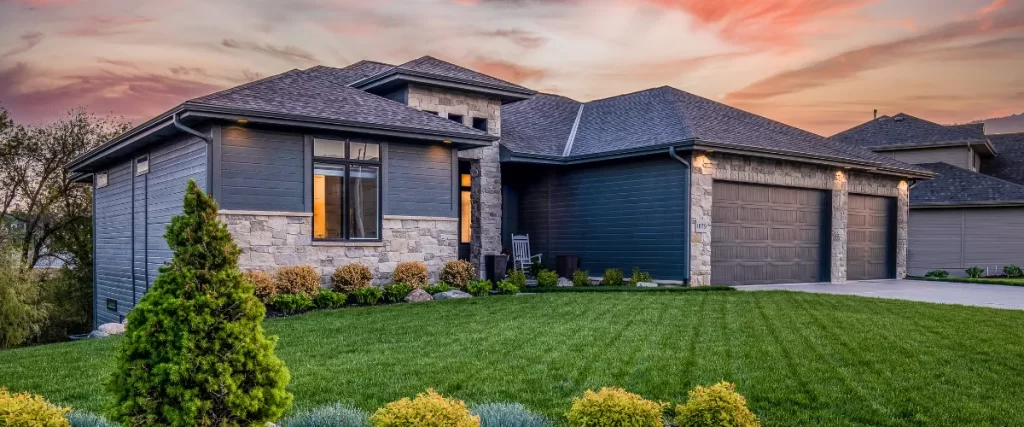If you live in Central New Jersey, you’ve likely felt the stress that comes with hurricane season. Whether it was Hurricane Sandy in 2012, Tropical Storm Ida in 2021, or even lesser-known Nor’easters that knock out power and flood basements, we’ve all seen how quickly the weather can turn destructive.
And if you’re planning to build or rebuild a home here, designing for extreme weather isn’t just smart… it’s necessary.
Let’s talk about how you can protect your investment, your family, and your peace of mind with hurricane and storm-resistant home design tailored specifically for Central NJ.

Why Central NJ Homeowners Need to Think About Storm-Resistant Design
While Central NJ isn’t as exposed as the Shore, we’re no strangers to severe weather. We’re in the path of hurricanes traveling up the Atlantic coast, get hit with heavy rain systems from the west, and face snowstorms and Nor’easters that often combine wind and flooding. It’s a cocktail of extreme weather.
- Counties like Middlesex, Somerset, and Mercer are frequently affected by high winds, flash floods, and falling trees.
- Our region experiences over 45 inches of rainfall annually, with the wettest months coming during hurricane season (August to October).
- Local creeks, rivers, and older stormwater systems increase the flood risk, even in neighborhoods that historically never had issues.
The Core Principles of Storm-Resistant Home Design
When you’re building in Central NJ, the key is to think ahead and build strong from the ground up. That means integrating specific architectural and engineering features that help your home stand firm in the face of powerful storms.
1. Wind-Resistant Structural Framing
- Use reinforced concrete or impact-resistant framing systems.
- Anchor the roof to the walls with hurricane ties or straps.
- Incorporate continuous load paths so the roof, walls, and foundation all work together to resist uplift and lateral forces.
2. Flood-Resistant Foundations
- Build on elevated slabs or piers if you’re near flood-prone areas like the Raritan River or Millstone River.
- Use flood vents to reduce pressure buildup during water surges.
- Avoid basements in high-risk flood zones.
3. Impact-Resistant Doors and Windows
- Install hurricane-rated windows and doors tested for windborne debris.
- Add storm shutters or panels for added protection during active storm events.
- Reinforce garage doors, which are one of the most vulnerable points during a storm.
4. Roofing That Holds Up
- Go for metal roofing or architectural asphalt shingles rated for 130+ mph winds.
- Consider a hip roof design, which is more aerodynamic than gables.
- Seal the roof deck with a secondary water barrier to prevent interior water damage if shingles are lost.
Building Materials That Make a Difference
Choosing the right materials plays a huge role in how your home stands up to the elements.
- Fiber Cement Siding: Doesn’t warp, crack, or rot under moisture or wind stress.
- Concrete Block or Insulated Concrete Forms (ICFs): Offers excellent wind and water resistance.
- Closed-cell spray foam insulation: Acts as a moisture barrier and increases structural integrity.
- Weather-resistant barrier systems behind your siding help block out wind-driven rain.
Local Building Codes & Storm-Resilient Standards
You can’t talk about storm-resistant design without mentioning code compliance. Fortunately, New Jersey adopted the International Residential Code (IRC) standards, which means homes in storm-prone areas must meet certain structural and material thresholds.
But in Central NJ, some towns go even further:
- Middlesex and Somerset Counties often require elevation certificates for new homes in flood zones.
- Local municipalities may restrict basement construction or require breakaway walls in flood-prone zones.
- You can consult local code offices like Middlesex County Construction or NJ DCA Building Codes for project-specific guidelines.

Best Practices for Storm-Resilient Site Planning
The way your home sits on your lot matters almost as much as how it’s built.
- Grade the land to divert water away from the home.
- Add French drains or swales to redirect excess water.
- Elevate HVAC and electrical systems above base flood elevation.
- Anchor sheds, decks, and other structures so they don’t become airborne hazards.
Don’t Forget the Backup Systems
Storm-resistant design also means preparing for what happens after the storm hits.
- Whole-home generators keep essential systems running.
- Battery storage systems paired with solar can bridge the gap during outages.
- Sump pumps with battery backups are a must in flood-prone basements.
Top Manufacturers for Storm-Resistant Building Products
If you’re building for storm resistance, you want materials and systems from brands you can trust—especially those designed and tested for extreme weather.
Leading Brands That Specialize in Storm-Resistant Materials
Andersen Windows & Doors Impact-resistant glass options tested against wind and debris.
[James Hardie (HardiePlank Siding)](https://www.jameshardie.com) Fiber cement siding built to withstand wind, rain, and temperature extremes.
GAF Roofing Systems Architectural shingles rated for high wind zones and built with waterproofing layers.
Simpson Strong-Tie Industry-leading structural connectors for roof-to-wall and foundation tie-downs.
Generac Reliable whole-home generators perfect for New Jersey’s power grid and storm conditions.
FAQ: Designing for Storms in Central NJ
Can I retrofit my existing home to be more storm-resistant?
Yes! Reinforcing your roof, replacing old windows with impact-resistant models, and installing flood vents are great first steps.
Is building a hurricane-resistant home more expensive?
It can cost more upfront, but you save over time through lower insurance premiums and less storm damage repair.
Do I need flood insurance in Central NJ?
If you’re in a FEMA flood zone, yes. Even if you’re not, it’s often worth the peace of mind.
What’s the best siding for storm resistance?
Fiber cement siding (like James Hardie) is durable, moisture-resistant, and far less likely to crack under pressure.
Are there state incentives for building storm-resistant homes?
While New Jersey doesn’t currently offer statewide incentives, your insurer might offer discounts, and FEMA grants are sometimes available for mitigation.

The Bottom Line: Design It Right the First Time
When you’re building in Central NJ, you’re not just building for sunny days—you’re building for the unexpected. And with hurricane season becoming more unpredictable every year, the smartest thing you can do is plan ahead.
Storm-resistant home design gives you long-term safety, peace of mind, and real resilience in the face of everything Mother Nature might throw at you.
Ready to talk about how to make your future home truly storm-ready? Contact us at (732) 913-0742 for your custom home project. We’ll walk you through smart design, product choices, and build strategies that help you weather any storm—literally.
